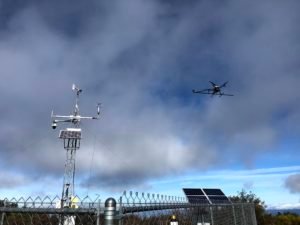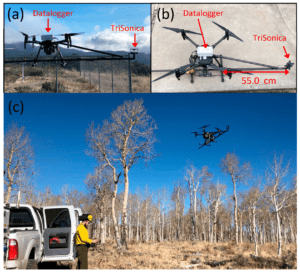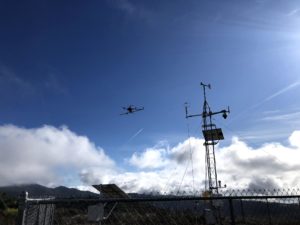Drones becoming a useful tool in wildfire meteorology, the effort to understand weather that leads to fire risk.
By DRONELIFE Staff Writer Jim Magill
As wildfires continue to rage across vast swaths of the western United States, researchers are developing the use of unmanned aerial vehicles (UAVs) to understand the weather systems that lead to the fires’ ignition and spread and to help develop tools to battle the blazes.
A team of researchers from the Fire Weather Research Laboratory at San Jose State University in California recently completed a study that demonstrated that a drone equipped with a sonic anemometer is an effective tool for taking vertical profiles of atmospheric variables, a process that would otherwise require the use of costly weather balloons or the construction of a meteorological tower.
What is Wildfire Meteorology?
“It tuns out the wildfire environment is poorly sampled and there have not been a lot of measurements around wildfires,” Craig Clements, professor at SJSU’s Fire Research Laboratory and leader of the project, said in an interview. “We need that data to better understand the fire environment for modeling so we can better predict changes, especially as the climate changes and fires get more intense.”
Clements began experimenting with using unmanned aircraft to measure meteorological conditions near wildfires in 2008, when he flew a small fixed-wing, gas-powered remote-controlled airplane through the smoke plumes of wildfires. Since then, the increasing sophistication of UAVs has greatly expanded the potential for their use in fire research, he said.
How Wildfire Meteorology with a Drone Works
Working in collaboration with U.S. Forest Service and the Desert Research Institute (DRI), the San Jose research team used a DJI Matrice 200 (M200) equipped with a TriSonica™ Mini Wind and Weather sensor, to sample the vertical wind profiles of three-dimensional winds generated by wildfires, according to a research paper.
Because the researchers wanted to measure vertical wind velocity, that had to position the sensor off to the side of the drone, to avoid having the prop wash from the drone’s rotors interfere with their measurements. The solution was to install a carbon-fiber boom, which positioned the sensor at a distance of about two times the propeller width away from the body of the UAV, to eliminate some of the influences of the prop wash.
The team used the anemometer with its data monitor powered through the USB port on the drone itself, said Matthew Brewer, a former graduate research assistant in the Fire Weather Research Laboratory.
Following a series of test flights, the team was ready to take the drone out for a test flight near a controlled fire in Fishlake National Forest, Utah, in November 2019. Unfortunately, the team was unable to fly close to a fire as they had hoped, when the organizers of the controlled burn decided to ignite the fire from a helicopter.
“Once there’s a helicopter in the air, then you really can’t fly a drone,” Clements said. “So, we had to do our flight before the helicopter ignition took place.”
Although the researchers were not able to actually fly near a fire, they were able to take the UAV to the site and fly it, taking vertical profiles of the atmosphere, which gave them two soundings, Brewer said. Because he was operating the drone under an FAA Certificate of Authorization, which allowed for flights above the normal 400-foot limit, Brewer was able to take one measurement at 1,500 feet above ground level.
“It showed that this platform could be used for high-resolution atmospheric sounding,” he said. “We found that the UAS can measure winds reasonably well for certain applications, such as monitoring fires and getting rough soundings. But further work is needed.”
Clements said the research demonstrated that UAVs can be used as a platform to take atmospheric measurements in the vicinity of wildfires, with many advantages over more traditional meteorological- sensor platforms such as weather balloons. For example, the sensor package carried by a balloon is disposable and designed for only a single use.
“The weather balloon goes up to 50,000 feet and then they burst and the sensor drops back to earth and they’re not collected, he said. Because the use of a drone allows the researchers to retain the sensor reuse, the scientists can afford to use a more sophisticated, and expensive, sensor package than they would with a balloon.
The use of the drone platform “gives us a lot more flexibility,” Clements said. “We can fly it wherever we want. Over time it will save us money.”
The last consideration is particularly important as the use of weather balloons can become quite expensive, especially for a relatively small research entity like the SJSU Fire Weather Research Laboratory. “Every time you launch a weather balloon you have a $200 sensor, a $10 balloon and probably about $10 in helium. And helium costs are going up.”
However, there are some limitations to the use of drones in wildfire meteorology, Clements said. One is vertical height, 1,500 feet for a drone, versus 50,000 feet for a weather balloon.
Another limitation with drones such as the Matrice 200 is because they are so small and lightweight, Clements said he is not sure that it could be flown directly above large-scale wildfires like those currently ravaging the West.
“I don’t think that many smaller drones could handle the extreme updraft associated with these fires,” he said. More likely researchers flying sensor-equipped drones would keep them away from the fire front, to take measurements in close proximity to the fire.
“If we were to take the drone to some smaller-scale grass fires, then we would fly the drone through the plume as we did in 2008,” he said.
Miriam McNabb is the Editor-in-Chief of DRONELIFE and CEO of JobForDrones, a professional drone services marketplace, and a fascinated observer of the emerging drone industry and the regulatory environment for drones. Miriam has penned over 3,000 articles focused on the commercial drone space and is an international speaker and recognized figure in the industry. Miriam has a degree from the University of Chicago and over 20 years of experience in high tech sales and marketing for new technologies.
For drone industry consulting or writing, Email Miriam.
TWITTER:@spaldingbarker
Subscribe to DroneLife here.
https://dronelife.com/2020/11/11/wildfire-meteorology-drones-provide-a-better-cheaper-way-to-understand-fire-risk/
 Unmanned Aerial Vehicle The latest drone news
Unmanned Aerial Vehicle The latest drone news






